I’ve had my share of tomato troubles as a home gardener. Issues like blossom-end rot and late blight can be tough. But don’t worry, you’re not alone.
Recently, three million people started a home garden, and tomatoes were in nine out of ten of them. This guide is for both new and experienced gardeners. It will help you fix 25 common tomato problems for a great harvest.
Key Takeaways
- Tomatoes are the most popular plant grown in home vegetable gardens.
- Common tomato problems include blossom end rot, early blight, late blight, and more.
- Identifying the root cause of tomato issues, such as calcium deficiency or environmental conditions, is key to finding the right solution.
- Selecting disease-resistant tomato varieties and practicing proper plant care can help prevent many tomato problems.
- This guide will provide you with the knowledge and tools to troubleshoot and solve 25 common tomato issues.
Introduction
Welcome to the world of tomato plant problems. This guide will help you fix common tomato issues. We’ll cover diseases, pests, and other problems. By learning about common tomato diseases and tomato pest control, you can grow more tomatoes.
The Importance of Addressing Tomato Problems Early
It’s key to spot and fix tomato plant problems early. If you wait, small issues can turn into big ones. This can hurt your tomato yield and make your plants look bad. By acting fast, you can stop problems before they get worse.
Overview of Common Tomato Issues
Tomatoes face many challenges, like diseases, pests, and stress. Some common problems include:
- Blossom end rot
- Early blight
- Late blight
- Septoria leaf spot
- Fusarium wilt
- Verticillium wilt
- Bacterial spot
- Bacterial speck
- Bacterial canker
- Tomato spotted wilt virus
- Mosaic virus
- Powdery mildew
Knowing the symptoms, causes, and solutions for these issues helps you keep your tomatoes healthy. We’ll go into more detail on these problems and how to fix them in the next sections.
“Identifying and addressing tomato plant problems early on is crucial for the health and productivity of your tomato crop.”
1. Blossom End Rot
Blossom end rot is a common problem for tomato growers. It shows up as a black patch on the tomato’s bottom as it ripens. This makes the fruit look bad and can make it taste bad too.
Symptoms
The main sign of blossom end rot is a dark, sunken spot on the tomato’s bottom. It starts small but can get bigger, covering a lot of the fruit. If it gets worse, the tomato can’t be eaten.
Causes
This problem is mainly from not having enough calcium in the plant. It can happen for many reasons, like:
- Not enough calcium in the soil
- Soil pH too low, making it hard for the plant to get calcium
- Watering too much or too little
- Harming the plant’s roots, which stops it from getting calcium
- Using too much nitrogen fertilizer, which messes with the plant’s calcium balance
Solutions
There are ways to stop and fix blossom end rot:
- Water the soil regularly to keep it moist.
- Add calcium-rich stuff like lime, bonemeal, or eggshells to the soil.
- Make sure the soil’s pH is right for tomatoes, between 6.5-7.0.
- Don’t use too much nitrogen fertilizer, as it can make calcium problems worse.
- Try a natural spray called Tomato Rot-Stop to fight blossom end rot.
Fixing the root causes of blossom end rot helps grow healthier, tastier tomatoes.
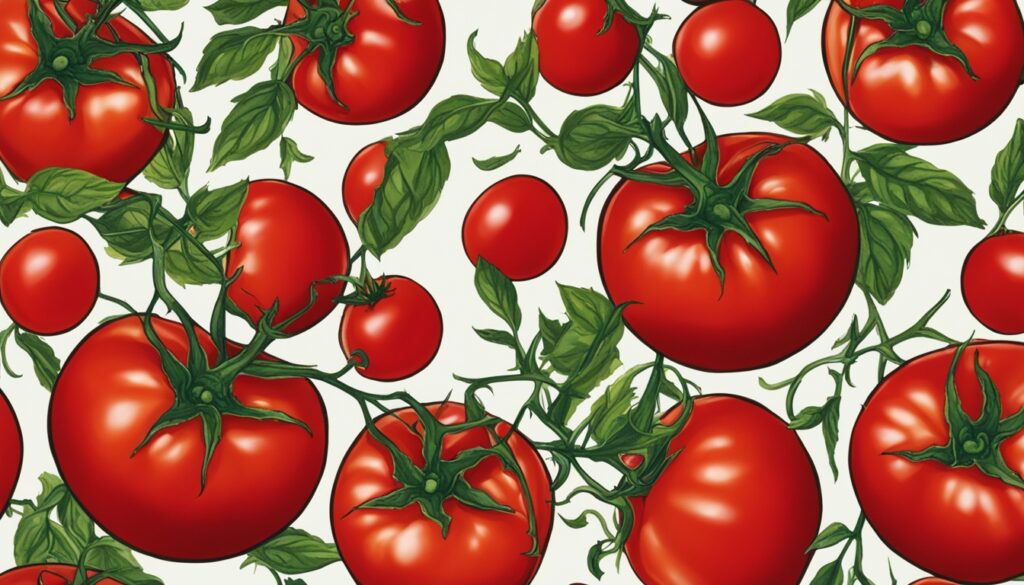
“Blossom end rot can result in direct fruit losses with reported levels as high as 50%.”
2. Early Blight
Early blight, also known as alternaria leaf spot, is a common disease in tomatoes. It attacks leaves, stems, and fruits. The fungus Alternaria linariae causes it and loves wet and humid places.
Symptoms
Early blight starts with small, brown spots on lower leaves with yellow rings. These spots grow and may join together, killing leaves and reducing yield.
Causes
The fungus can survive winter in soil with infected plant parts. It spreads through water, wind, insects, and machines in spring. It grows best in warm, wet weather, making it hard to control.
Solutions
Here are ways to fight early blight:
- Choose certified disease-free seeds and resistant tomato varieties like ‘Mountain Fresh Plus F1’ or ‘Juliet F1’.
- Trim lower leaves and keep good ventilation to stop disease.
- Use preventative fungicide sprays every 10 days with different chemicals to avoid resistance.
- For organic tomatoes, try Serenade or other organic fungicides.
- Don’t overuse azoxystrobin to stop fungus resistance.
- Watch your tomatoes closely and hand-pick any sick leaves or stems to slow the disease.
These steps can help you fight tomato early blight and keep your crops safe.
3. Late Blight
Late blight is a disease that can destroy tomatoes and potatoes. It spreads fast in cool, damp places. It’s important to watch for and manage this disease.
Symptoms
Look for water-soaked spots and lesions on leaves, stems, and fruit. These areas may turn gray and moldy. If not treated, the whole plant can get infected quickly.
Causes
This disease comes from infected potatoes or tomatoes, or from spores in the wind. It can also live in potato cull piles or on weeds like hairy nightshade. Cool, wet weather helps it spread fast.
Solutions
- Watch for late blight in your area on the usablight.org website and act fast.
- Use fungicides like Actinovate or Copper Fungicide to prevent the disease.
- Change the type of fungicides you use to stop them from becoming resistant.
- Use drip irrigation instead of overhead watering to keep leaves dry.
- Remove plants with late blight and don’t keep tomatoes with spots.
- Plant tomatoes away from other crops and avoid areas where blight has been a problem before.
By being careful and acting quickly, you can protect your tomatoes from late blight.
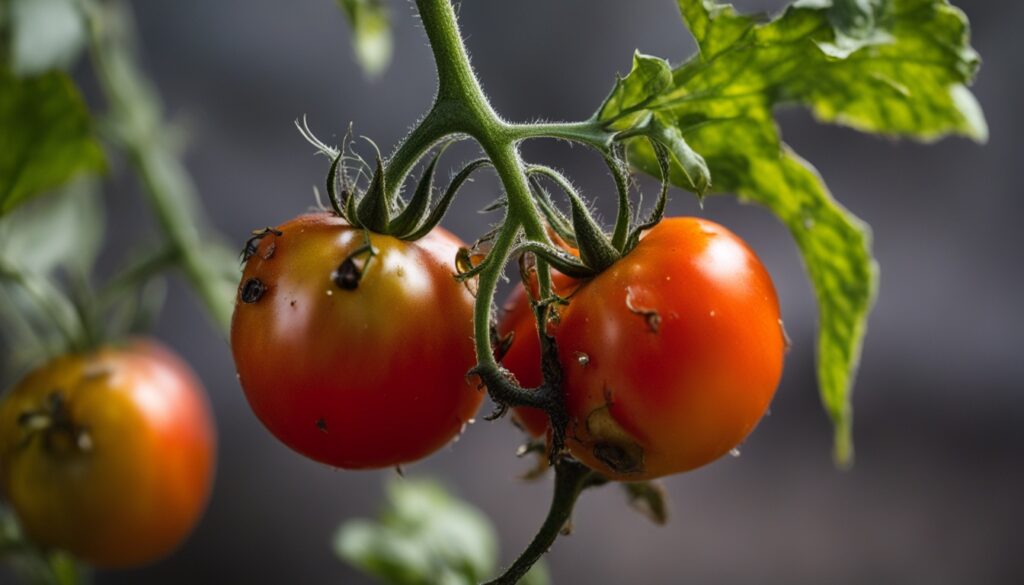
4. Septoria Leaf Spot
Septoria leaf spot is a common and destructive disease in tomatoes. It’s caused by the fungus Septoria lycopersici. This disease can make tomato plants lose up to 100% of their yield. It’s important for growers to know how to spot, cause, and manage this disease.
Symptoms
The first signs of Septoria leaf spot show up on the lower leaves of tomato plants. Small, round, gray spots with dark brown edges appear. These spots grow bigger, merge, and turn the leaves yellow and dead.
The spots are 1/16 to 1/8 inches wide. You might see small black fruiting bodies in the center of the spots.
Causes
Septoria leaf spot comes from the fungus Septoria lycopersici. It can live in infected plant parts and soil. The fungus spreads through water, insects, tools, and people.
It thrives in warm (60-80°F), humid weather. This makes it a big problem for tomato growers in many places.
Solutions
- Use fungicides with copper or potassium bicarbonate to stop the disease. Chlorothalonil is a good choice for fighting Septoria leaf spot.
- Keep plants well-spaced and prune them to improve air flow.
- Put mulch around plants to keep water from splashing and spreading spores.
- Water plants at the base, not on the leaves, to prevent disease spread.
- Remove and throw away infected leaves and debris to cut down on spores.
- Try a natural fungicide mix with baking soda, vegetable oil, and dish soap to fight pests and diseases.
Using cultural, sanitary, and chemical methods can help manage Septoria leaf spot. This keeps tomato crops safe from this common fungal disease.
5. Fusarium Wilt
Fusarium wilt is a disease that can destroy tomato plants. It’s caused by a fungus called Fusarium oxysporum f. sp. lycopersici. This disease is very common in tomatoes in many places, including Maryland.
Symptoms of Fusarium Wilt
Look for signs like yellow and brown leaves, and leaves and stems that wilt. Infected plants might seem better overnight but wilt again the next day. Scraping the stem of an infected plant shows discolored vascular tissue, confirming the disease.
Causes of Fusarium Wilt
The Fusarium oxysporum fungus can live in soil for up to 10 years without a host plant. It thrives in warm, acidic soil and high humidity. Symptoms may appear mid to late in the season, as the fungus blocks the plant’s vascular system.
Solutions for Fusarium Wilt
- Rotate crops away from susceptible plants like tomatoes, potatoes, peppers, and eggplants for 3-5 years to help reduce disease pressure.
- Consider using grafted tomato plants, which combine the disease resistance of the rootstock with the desirable fruit characteristics of the scion.
- Maintain optimal soil pH, aiming for a neutral range of 6.5-7.0, as Fusarium thrives in acidic conditions.
- Avoid excessive nitrogen fertilization, which can exacerbate the disease.
- Ensure good sanitation practices, such as washing tools and equipment between fields to prevent the spread of contaminated soil.
- For severe infestations, the fungicide Miravis Prime may provide some control, but options are limited for homeowners.
By being vigilant and using cultural practices, gardeners can reduce the impact of this tough disease. Keeping plants healthy is crucial to fighting off Fusarium oxysporum and other tomato diseases.
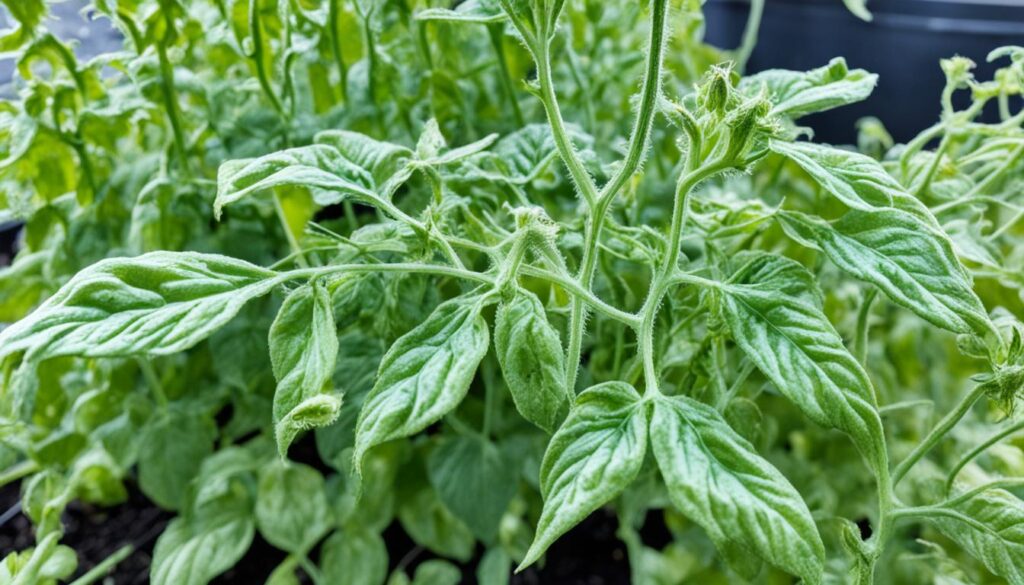
6. Verticillium Wilt
Verticillium wilt is a common disease that affects tomato plants. It can cause a lot of damage if not treated. This disease, Verticillium dahliae, can live in the soil for years. This makes it hard for tomato growers to fight it.
Symptoms
Signs of verticillium wilt include yellowing and wilting of the lower leaves. This leads to stunted growth and less fruit. Unlike fusarium wilt, it makes all leaves turn yellow evenly.
Causes
Verticillium wilt likes cool soil, between 55°F and 75°F. This is a big problem in spring and early summer. It can infect many plants, like tomatoes, potatoes, and eggplants.
Solutions
To fight verticillium wilt, try these steps:
- Choose tomatoes that resist this disease, like Celebrity, Mountain Pride, and QuickPik.
- Rotate crops for 4-6 years to lower the disease in the soil.
- Keep the soil moist, as this disease thrives in cool, wet soil.
- Use preventive fungicides, like copper or Bacillus subtilis, to stop the disease.
By acting early, gardeners can save their tomato plants from this disease. This way, they can have a good harvest.
7. Bacterial Spot
Bacterial spot is a common disease in home gardens. It’s a big problem in warm and humid weather. The bacteria causing it are Xanthomonas vesicatoria, X. euvesicatoria, X. gardneri, and X. perforans.
Symptoms
This disease shows up as small, dark spots on tomato leaves. These spots can also turn yellow and brown. They often appear on the leaf edges and tips.
It can also infect stems, flowers, and fruit. This leads to dark spots with white halos that may get bigger.
Causes
The bacteria causing this disease can live in the soil for up to two years. They spread through tools, hands, or water. Volunteer tomato or pepper plants can also spread the bacteria.
Solutions
Here are ways to fight bacterial spot:
- Use tomatoes that are resistant to disease.
- Check and pick healthy transplants.
- Keep the garden clean by removing debris at the end of the season.
- Apply copper-based fungicides, but be aware of resistance.
- Try biocontrol agents or other treatments like the spray program of Actigard® with copper + Mancozeb®.
Managing bacterial diseases is tough. You might need to use both prevention and treatment to control tomato bacterial spot and other tomato bacterial diseases.
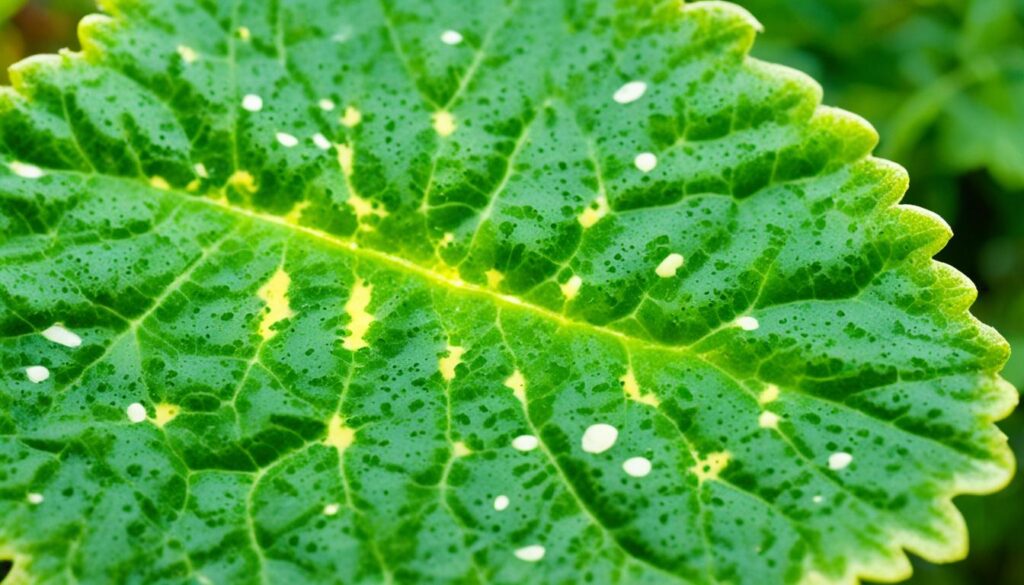
8. Bacterial Speck
In the southeastern United States, tomato growers face many challenges with bacterial diseases. Bacterial speck is one big problem. It’s caused by Pseudomonas syringae pv. tomato. This bacterium can harm tomato plants in many ways.
Symptoms
Bacterial speck shows up as small, dark spots on tomato leaves. These spots are less than ⅛ inch wide and can be black or brown. They might have a yellow ring around them.
Infected leaves can turn yellow or brown too. This makes the plant look bad and can hurt its health.
Causes
Bacterial speck is hard to beat for tomato farmers. The bacteria, Pseudomonas syringae pv. tomato, can stay in the soil and be in seeds. It likes warm, moist places to grow.
Solutions
There are ways to fight bacterial speck. Choosing tomatoes that are resistant to the disease helps. Also, getting rid of infected plants stops the bacteria from spreading.
Using copper-based fungicides can also help. But, we must use these carefully to avoid making the bacteria resistant. Organic farmers can use other products to fight the disease too.
By being careful and using different methods, farmers can reduce the effects of bacterial speck. This keeps their tomatoes safe from this tough bacteria.
9. Bacterial Canker
Bacterial canker is a serious disease that can hurt tomato production a lot. It’s caused by Clavibacter michiganensis subsp. michiganensis (Cmm). This disease can harm tomato plants of all ages, affecting leaves and fruit.
Symptoms
Early signs include small, dark spots on leaves, which turn yellow and brown. Leaves may wilt, and the plant looks unhealthy. On the fruit, look for raised lesions with white edges, about 1/16 inch wide.
Causes
The Cmm pathogen spreads through contaminated seeds, plant debris, and equipment. It thrives in warm, moist conditions, between 75°F and 90°F. This makes it spread fast.
Cmm can live on plant residues for up to 3 years and on equipment for up to 7 months. This makes it hard for tomato growers to fight.
Solutions
Stopping bacterial canker once it starts is hard because it spreads quickly. But, there are ways to prevent it:
- Use treated or disease-free seeds and get healthy transplants from trusted growers.
- Move tomatoes and other solanaceous crops away from each other for at least 3 years.
- Clean tools, equipment, and trellis materials with a 1 part bleach to 9 parts water solution.
- Water plants in the early morning to reduce pathogen spread.
- Use fixed copper plus mancozeb or Actigard to lessen disease, but prevention works best.
Bacterial canker is a big problem, but with the right steps, tomato growers can lessen its effects.
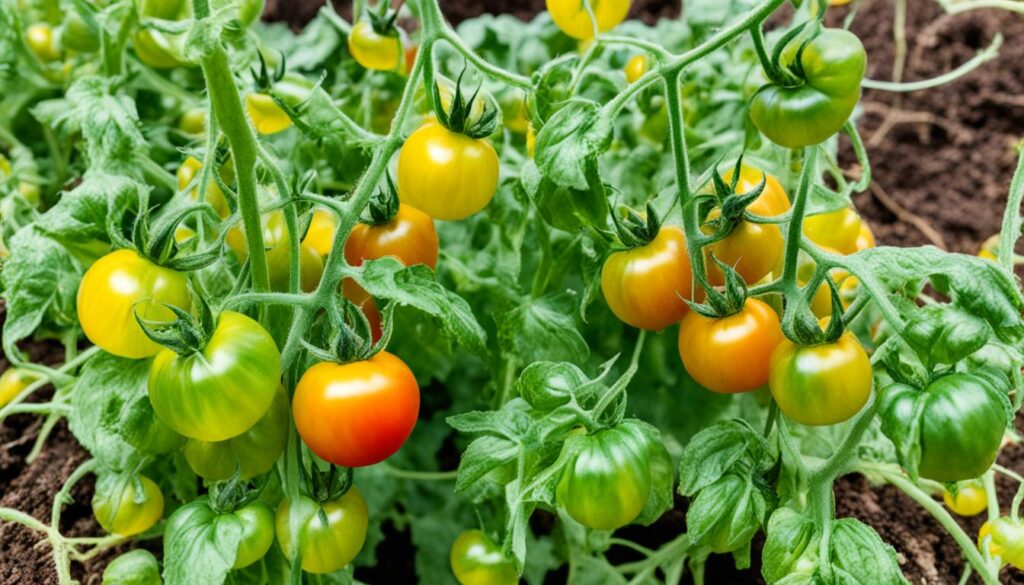
It’s important to fight bacterial canker early, as it can spread fast and harm tomato plants. By following these best practices, growers can keep their crops safe and healthy.
10. Tomato Spotted Wilt Virus
Tomato plants face many viral diseases, but Tomato Spotted Wilt Virus (TSWV) is a big problem. It can greatly reduce tomato yields in the U.S.
Symptoms
TSWV symptoms can look like other tomato diseases, making it hard to spot. Look for curled leaves, distorted leaves, and spots on leaves and fruit. Infected plants grow less and produce fewer tomatoes.
Causes
Thrips, tiny insects, spread TSWV by feeding on plants. They can carry the virus from one plant to another. The virus can also spread through dirty tools, clothes, or the wind.
Solutions
- Choose virus-resistant tomato varieties to help fight TSWV.
- Keep your garden clean by cleaning tools and removing sick plants.
- Use insect control measures like insecticides and barriers to fight thrips.
- Watch your tomatoes closely for TSWV signs and act fast if you find them.
To beat tomato spotted wilt virus, use resistant plants, watch closely, and manage pests well. These steps can help protect your tomatoes from this harmful disease.
“TSWV can affect both outdoor and indoor tomato and pepper plants. It causes about $9 million in losses each year in Georgia alone.”
11. Mosaic Virus
Tomato mosaic virus (ToMV) is a common disease in tomatoes. It causes symptoms that hurt the plant’s health and yield. The virus makes a mosaic pattern on leaves, which is why it’s called the mosaic virus.
Symptoms
The main signs of tomato mosaic virus include:
- Leaves twisting, curling, and becoming distorted in shape
- Leaves being smaller than normal, with a rough, crinkled texture
- Discoloration of leaves, with a mottled or mosaic-like pattern of light and dark green patches
- Stunted plant growth and reduced fruit production
Causes
This virus spreads through contact with infected plants or tools. Aphids and other insects can also spread it. It can stay in the soil and on plant debris, making it hard to get rid of.
Solutions
To fight tomato mosaic virus, we need a strong plan:
- Choose tomatoes that can fight the disease.
- Clean your tools and clothes before touching the plants.
- Take out and throw away any plants with the virus.
- Use covers to keep insects away from your tomatoes.
- Change what you grow to break the disease cycle.
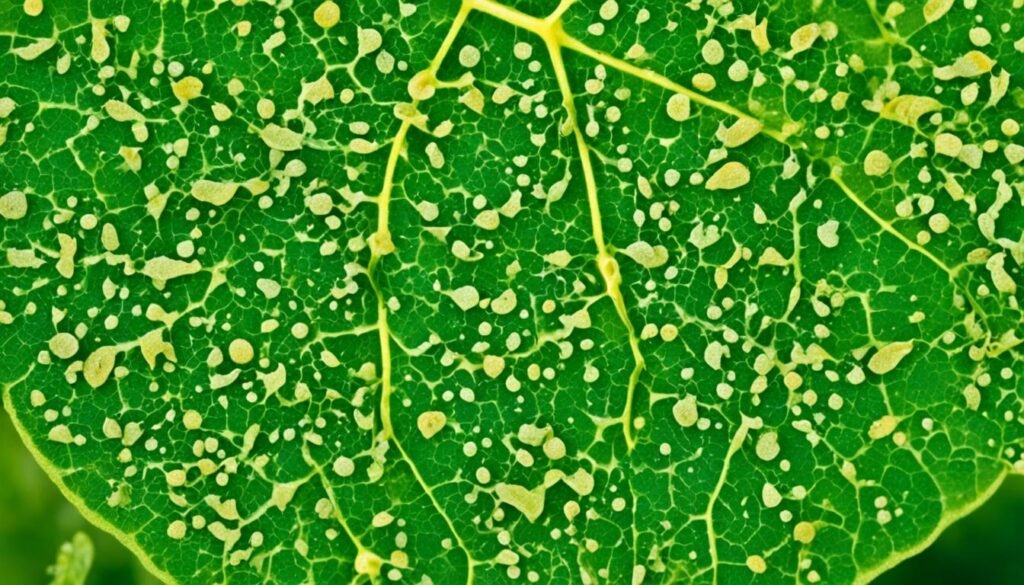
| Symptom | Cause | Solution |
|---|---|---|
| Leaves twisting, curling, and becoming distorted in shape | Tomato mosaic virus (ToMV) | Plant virus-resistant tomato varieties, practice good sanitation, remove and dispose of infected plants, use row covers to prevent insect vectors |
| Leaves being smaller than normal, with a rough, crinkled texture | Tomato mosaic virus (ToMV) | Plant virus-resistant tomato varieties, practice good sanitation, remove and dispose of infected plants, use row covers to prevent insect vectors |
| Discoloration of leaves, with a mottled or mosaic-like pattern of light and dark green patches | Tomato mosaic virus (ToMV) | Plant virus-resistant tomato varieties, practice good sanitation, remove and dispose of infected plants, use row covers to prevent insect vectors |
| Stunted plant growth and reduced fruit production | Tomato mosaic virus (ToMV) | Plant virus-resistant tomato varieties, practice good sanitation, remove and dispose of infected plants, use row covers to prevent insect vectors |
12. Powdery Mildew
Symptoms
Powdery mildew is a common fungal disease that affects many plants, including tomatoes. It shows up as a white, powdery stuff on leaves, stems, and flowers. This can slow down plant growth and make the tomatoes less tasty if not treated.
It thrives in warm, moist places, especially on cloudy days. The spores can easily move from one plant to another, making it a big problem for tomato farmers.
To stop powdery mildew, keep plants well-spaced and prune them. Also, choose tomato types that resist this disease, like Grace and DRW 5007. But, you can’t always stop it completely.
FAQ
What are some common tomato problems and their solutions?
This guide tackles 25 common tomato issues, like blossom end rot and powdery mildew. It explains symptoms, causes, and how to fix them. This way, you can grow more tomatoes.
How can I identify and prevent blossom end rot on my tomatoes?
Blossom end rot makes tomatoes have a black spot on the bottom. It happens when tomatoes don’t get enough calcium or the soil’s pH is wrong. Not watering evenly can also cause it.
To stop it, water your tomatoes regularly, add calcium to the soil, and use Tomato Rot-Stop.
What are the signs of early blight and how do I manage it?
Early blight looks like brown spots with yellow rings on tomato leaves. It can kill leaves and lower yields. This disease loves wet weather.
To fight it, spray with Actinovate or Copper Fungicide. Also, don’t get water on the leaves when you water.
How can I identify and manage late blight on my tomato plants?
Late blight causes wet patches and lesions on tomatoes, stems, and leaves. It spreads fast in the right weather. If you see it, spray with Actinovate or Copper Fungicide.
Check the usablight.org map for updates and take action.
What are the symptoms of septoria leaf spot, and how do I control it?
Septoria leaf spot makes small gray spots on tomato leaves. These spots grow and turn leaves yellow and dead. It often comes with early blight.
To fight it, use fungicides like Actinovate or Copper Fungicide. And don’t water the leaves.
How can I identify and address fusarium wilt in my tomato plants?
Fusarium wilt makes leaves turn yellow and wilt, sometimes recovering at night. It’s a fungus in the soil. Scraping the stem shows discolored inside.
Remove and throw away infected plants. Don’t put them in the compost.
What are the signs of verticillium wilt in tomatoes, and how do I manage it?
Verticillium wilt also wilts and yellows leaves, like fusarium wilt. It’s another soil fungus. Choose disease-resistant tomatoes and keep the soil healthy.
Avoid planting tomatoes where this disease was before.
How can I identify and treat bacterial spot and bacterial speck on my tomatoes?
Bacterial spot and speck make dark spots on leaves, causing yellowing and browning. These bacteria can stay in the soil and on seeds. Use resistant tomatoes, clean your garden, and spray with copper fungicides.
What are the symptoms of bacterial canker, and how do I manage it?
Bacterial canker also spots leaves, yellows, and browns them. Manage it by using resistant tomatoes, cleaning your garden, and spraying with copper fungicides.
How can I identify and prevent tomato spotted wilt virus?
Tomato spotted wilt virus curls and distorts leaves. Thrips spread it. There’s no chemical cure. Use virus-resistant tomatoes and keep your garden clean.
What are the symptoms of mosaic viruses in tomatoes, and how do I manage them?
Mosaic viruses twist, curl, and make leaves small and rough. Plant disease-resistant tomatoes to fight them.
What are the signs of powdery mildew on tomatoes, and how do I control it?
Powdery mildew looks like white powder on leaves and stems. Use fungicides, improve air flow, and pick mildew-resistant tomatoes.
Source Links
- 23 Common Tomato Plant Problems and How to Fix Them
- Troubleshooting Tomato Problems, Tomato Pests | Gardener’s Supply
- Key to Common Problems of Tomatoes
- Top 10 Tomato Problems and Solutions
- Tomato Plant Diseases, Pests, & Problems – Garden Design
- Tomato Troubles: Common Problems with Tomatoes
- Blossom-End Rot of Tomato
- Blossom End Rot
- Prevent Blossom-End Rot: Tomato Diseases and Problems | Gardeners.com
- Early blight in tomato and potato
- Tomato Problems: Early Blight
- Extension | Early Blight of Tomatoes
- Late blight of tomato and potato
- Extension | Late Blight of Tomatoes
- Tomato Diseases & Disorders
- Save Your Tomatoes From Septoria Leaf Spot
- Septoria Leaf Spot of Tomato
- Septoria Leaf Spot
- Fusarium Wilt of Tomato | NC State Extension Publications
- Fusarium wilt
- Recognizing Tomato Problems – 2.949 – Extension
- Possible Causes of Sudden Wilt and Death in Tomatoes
- Tomato Leaf Problems: A Visual Guide | You Should Grow
- Bacterial spot of tomato and pepper
- Bacterial diseases of tomato: bacterial spot, bacterial speck and bacterial canker
- Controlling Bacterial Spot on Tomato and Pepper
- Bacterial Speck and Bacterial Spot in Tomatoes
- Bacterial Diseases of Tomato | Integrated Pest Management
- Bacterial canker of tomato
- Tomato Spotted Wilt Virus
- Tomato Spotted Wilt Virus (TSWV): a virus you should know and be able to identify!
- Tips for Managing Tomato Spotted Wilt Virus (TSWV)
- Common Diseases of Tomatoes- Part II: Diseases Caused by Bacteria, Viruses and Nematodes – Oklahoma State University
- 17 Tomato Diseases You Should Watch Out for This Growing Season
- Powdery Mildew in Tomatoes: Identification and Prevention
- Powdery Mildew on Tomato | Integrated Pest Management
- Powdery Mildew on Tomatoes
